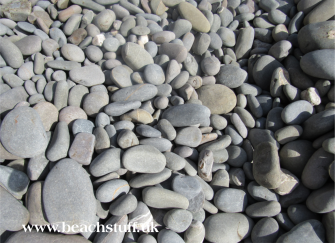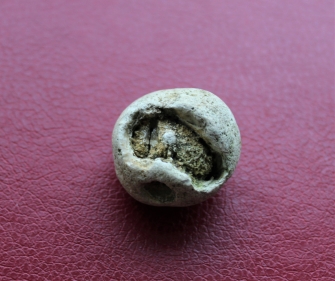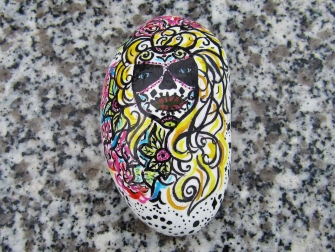

Stones and things that
look like stones
Slate
Particularly in North Devon, slate occurs very commonly on our beaches as a significant amount of our geology is made of layers of slate. Slate is quite a soft rock so it erodes easily and so we find many rounded pieces on the beach. Eroding slate rock can also form lovely rockpools leading to an abundance of rockpool creatures. Pieces of slate are generally found as very flat stones with rounded edges.
Quartz-rich stones
White stones tend to stand out on a beach and they are stones which are rich in quartz. As quartz is one of the hardest minerals we have, it often remains when other softer rocks have eroded away.
The photo below shows a layer of quartz in slate. As the slate erodes, the (harder) quartz will be released and may end up on the beach.


Quartz veins running through pebbles
Shale stone pebbles
Shale is usually smooth, and grey. it is made of very fine silts or muds which were laid down eons ago and have turned to rock. They are generally found as rounded stones or rocks on beaches as they are relatively soft and evenly eroded by wave action.


Hag stones
Stones with a naturally occurring hole running all the way through them are known as hag stones and have long been regarded as lucky. Holes can be caused in nature by boring sponges, burrowing worms or molluscs, such as piddocks, or by water erosion following a weakness in the stone. Cheating by drilling a hole through any old stone you pick up is liable to bring you curses and pestilence and other undesirable occurences.

Limestone
Layers of limesstone in a cliff face. Limestone can sometimes be a fruitful source of marine fossils. Often yellowish.

Dog-tooth calcite
These spikes can form where calcite leeches out of the limestone to form crystals.


Flint
Flint is a hard, shiny, almost glassy, stone within layers of chalk. It is often pointed and flaky rather than rounded like the softer chalk surrounding it. It is formed from a complex process deriving from animals such as sponges, urchins and other marine animals in the sediments lain down to form the rocks. Because it is hard, and can easily form sharp edges, it was used as first human tools. If you find a flint arrow head, you have good reason to be absolutely delighted with yourself!

While flint is generally smooth and featureless, sometimes the fossilised remains ofthe creatures from which it was formed can be found.
This seemingly smooth ball of chalky flint below revealed a sponge when turned over!


Nine year old Lotte found this incredibly impressive fossilised urchin in some chalky flint. Thanks for letting us use your photos Lotte!
Chalk
Below are pieces of flint with chalky layers intact.

Things that look like stones, but may be something else entirely...
Coal
Pieces of coal can get washed up, perhaps dropped by boats that are transporting it.
Patches of coal dust can also end up on our beaches (below).
Does your stone look like a round brown stone but feel very light? It may not be a stone at all but a clay pebble, made for use in hydroponics - growing plants without soil. These round 'stones' - only a centimetre or less in diameter - get washed up on our beaches pretty often.
Does your stone have spines? A star shape made of tiny holes? Chances are it probably isn't a stone, but a sea potato.
Pebble art
Some creative souls are painting beach pebbles for people to find. 'Keep or rehide' says the pebble below which I found under a bench looking out to sea. I decided to rehide this one for someone else to find.


















